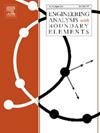三维稳定不可压缩斯托克斯方程和纳维-斯托克斯方程的简化变分多尺度元素自由伽勒金方法
IF 4.2
2区 工程技术
Q1 ENGINEERING, MULTIDISCIPLINARY
Engineering Analysis with Boundary Elements
Pub Date : 2024-10-07
DOI:10.1016/j.enganabound.2024.105984
引用次数: 0
摘要
本文扩展了简化变分多尺度无元素 Galerkin(RVMEFG)方法,用于求解三维稳定不可压缩斯托克斯方程和纳维-斯托克斯方程。该方法在三维变分多尺度无元素方法(VMEFG)的基础上进行了简化,动量守恒方程采用标准 Galerkin 离散法,质量守恒方程采用变分多尺度方法。RVMEFG 方法继承了 VMEFG 方法的优点,允许对速度和压力进行等线性基近似,避免了 Ladyzhenskaya-Babuška-Breezi(LBB)条件。同时,它还能自然生成稳定矩阵。此外,与 VMEFG 方法相比,RVMEFG 方法可以节省计算成本。为了验证该方法的数值稳定性、计算精度和效率,对五个数值问题进行了测试,并与精确解、VMEFG 解进行了比较。结果表明,RVMEFG 方法可以避免数值振荡,具有更高的计算效率,可以节省计算时间。同时,它能保证三维稳定不可压缩斯托克斯和纳维-斯托克斯问题的数值精度。本文章由计算机程序翻译,如有差异,请以英文原文为准。
The reduced variational multiscale element free Galerkin method for three-dimensional steady incompressible Stokes and Navier–Stokes equations
In the paper, we extend the reduced variational multiscale element free Galerkin (RVMEFG) method to solve the three-dimensional steady incompressible Stokes and Navier–Stokes equations. This method is simplified based on the three-dimensional variational multiscale element free method (VMEFG), which the standard Galerkin discretization is used to momentum conservation equation and the variational multiscale method is used to mass conservation equation. The RVMEFG method inherits the advantages of the VMEFG method, which allows equal linear basis approximation of both velocity and pressure and avoids the Ladyzhenskaya–Babuška–Breezi (LBB) condition. Meanwhile, it can naturally generate the stabilization matrix. Furthermore, compared to the VMEFG method, the RVMEFG method can save computational cost. To verify the numerical stability, computational accuracy and efficiency of the method, five numerical problems are tested, and compared with the exact solution, VMEFG solution. It is shown that the RVMEFG method can avoid numerical oscillations and have higher computational efficiency which can save computational time. Meanwhile, it can guarantee the numerical accuracy for the three-dimensional steady incompressible Stokes and Navier–Stokes problems.
求助全文
通过发布文献求助,成功后即可免费获取论文全文。
去求助
来源期刊

Engineering Analysis with Boundary Elements
工程技术-工程:综合
CiteScore
5.50
自引率
18.20%
发文量
368
审稿时长
56 days
期刊介绍:
This journal is specifically dedicated to the dissemination of the latest developments of new engineering analysis techniques using boundary elements and other mesh reduction methods.
Boundary element (BEM) and mesh reduction methods (MRM) are very active areas of research with the techniques being applied to solve increasingly complex problems. The journal stresses the importance of these applications as well as their computational aspects, reliability and robustness.
The main criteria for publication will be the originality of the work being reported, its potential usefulness and applications of the methods to new fields.
In addition to regular issues, the journal publishes a series of special issues dealing with specific areas of current research.
The journal has, for many years, provided a channel of communication between academics and industrial researchers working in mesh reduction methods
Fields Covered:
• Boundary Element Methods (BEM)
• Mesh Reduction Methods (MRM)
• Meshless Methods
• Integral Equations
• Applications of BEM/MRM in Engineering
• Numerical Methods related to BEM/MRM
• Computational Techniques
• Combination of Different Methods
• Advanced Formulations.
 求助内容:
求助内容: 应助结果提醒方式:
应助结果提醒方式:


